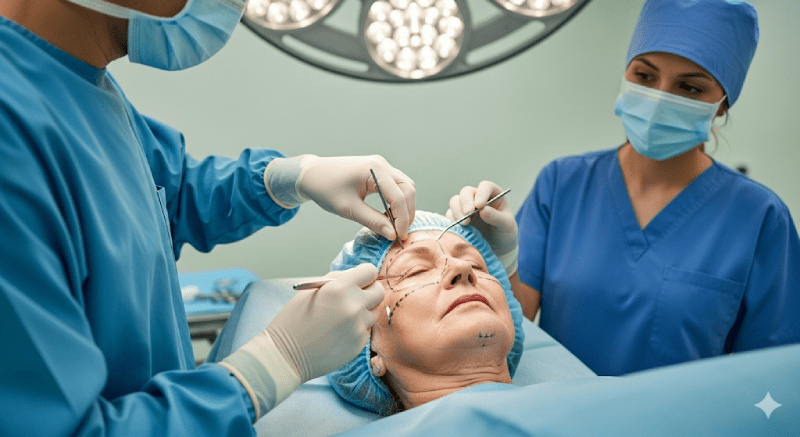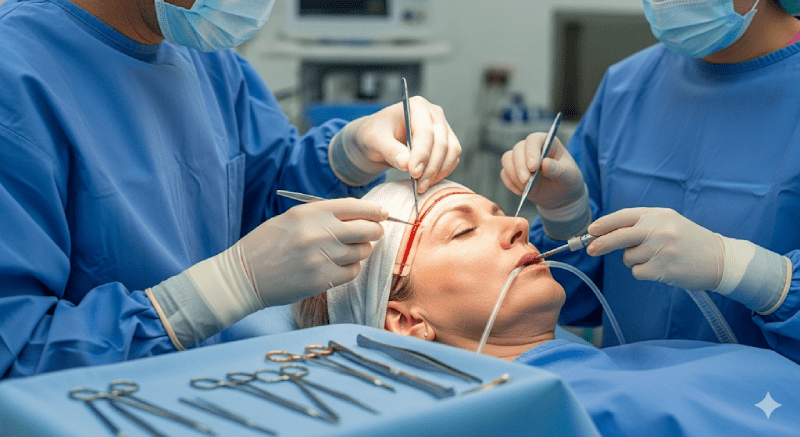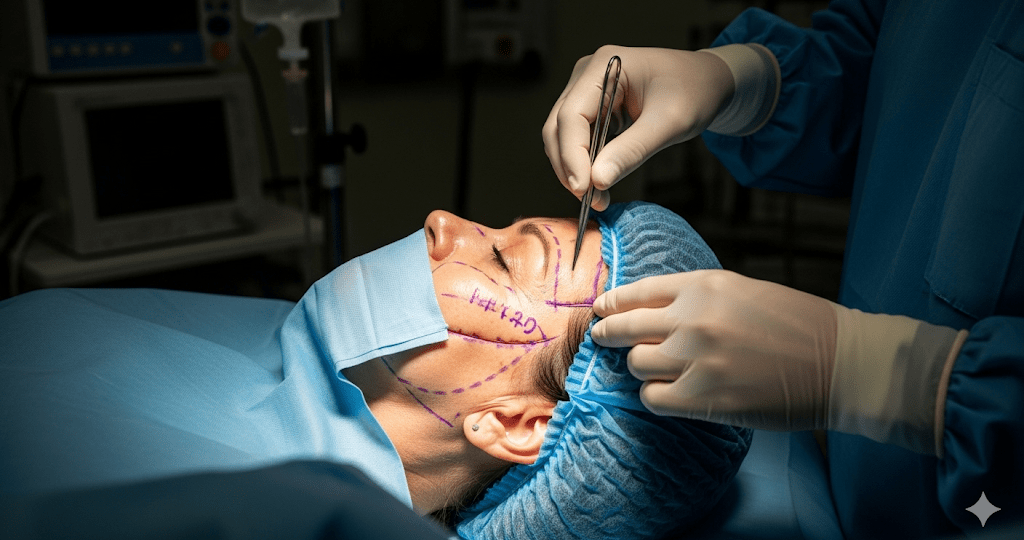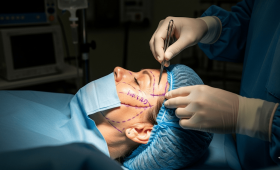What is the fundamental difference between a facelift and a neck lift?
A facelift is a surgical operation performed to address sagging, deep wrinkles, and loose skin, particularly in the mid and lower facial regions. This procedure targets issues such as sagging cheeks, a poorly defined jawline, and deepening nasolabial folds. A neck lift, on the other hand, is a separate operation performed to correct aesthetic problems like loose skin, submental fat (double chin), and the “turkey neck” appearance in the neck and under-chin area. While the two procedures are often performed together, they focus on different anatomical regions.
What problems does a facelift solve?
A facelift (rhytidectomy) fundamentally solves the problems of sagging and wrinkles that arise due to aging. The most common issues targeted are sagging skin on the cheeks and jawline, marionette lines extending from the corners of the mouth to the chin, and deepening nasolabial folds. The surgery tightens the lower and mid-face, providing a younger, more dynamic, and rested appearance.
What problems does a neck lift solve?
A neck lift is often seen as a complement to a facelift but can also be performed as a standalone procedure. This surgery specifically targets vertical bands in the neck known as “turkey neck,” fat deposits in the double chin area, and loose, sagging skin on the neck and under the chin. The surgery defines the neck contour, improves the angle between the neck and jawline, and creates a tighter, smoother neck appearance.
Can both operations be performed at the same time?
Yes, facelift and neck lift operations are commonly performed together. This combination ensures a more natural and aesthetically harmonious transition from the jawline to the neck. By addressing signs of aging in both the face and neck in a single surgery, a more comprehensive and cohesive rejuvenation is achieved. Performing them at the same time can be more advantageous for patients, as it means a single anesthesia session and one recovery period.
In what situations is a facelift alone sufficient?
If a patient’s signs of aging are concentrated primarily in the mid and lower face, but they do not have significant sagging, a double chin, or muscle bands in the neck, a facelift alone may be sufficient. This situation is often seen in younger patients considering a facelift or individuals who have maintained their neck area well. The patient’s overall facial and neck structure is the most important factor in the surgeon’s decision about which procedure is appropriate.
In what situations is a neck lift alone sufficient?
A neck lift alone is ideal for patients who do not have significant facial sagging but do have loose skin, a double chin, or vertical muscle bands on the neck and under the chin. This is often seen in younger individuals or those who are genetically predisposed to showing signs of aging in the neck area earlier. A neck lift alone improves the neck contour without altering the existing youthful appearance of the face.
How long do the surgeries take?
The duration of a facelift surgery varies depending on the scope of the operation and the technique the surgeon will use. It generally takes between 3 to 6 hours. A neck lift surgery is shorter, and can be completed in 1 to 2 hours. When the two procedures are performed together, the total surgery time can range from 4 to 7 hours. The duration of the surgery is flexible and depends on the patient’s needs and the surgeon’s plan.
What type of anesthesia is used?
Facelift and neck lift operations are typically performed under general anesthesia. This ensures that the patient is fully asleep during the surgery and feels no pain or discomfort. Given the duration and complexity of the operation, general anesthesia is the safest and most comfortable option for both the patient and the surgeon. Simpler and more limited lifting procedures can sometimes be done with local anesthesia and sedation.
How long is the recovery period?
While the recovery process after facelift and neck lift surgeries varies individually, it is generally similar. Swelling and bruising are at their peak during the first few days. Bruising and significant swelling largely subside within 10 to 14 days, and patients can return to their social lives. However, it can take 6 to 12 months for the final result to fully settle and all swelling to disappear.
Is there pain after surgery?
Facelift and neck lift surgeries are not known to be painful operations. Patients typically describe a feeling of “pressure” or “tightness” rather than “pain.” Any discomfort can be easily managed with prescription pain medication. As swelling and bruising decrease, this feeling of tightness also subsides and largely disappears within a few days.

Where are the scars located?
In a facelift, the incisions are typically hidden in the temporal area, starting in front of the ear, around the earlobe, and behind the ear into the hairline. In a neck lift, the incision is made under the chin and behind the ear. Since these incisions are concealed within the hairline and natural creases, they become almost invisible by the end of the recovery process. An experienced surgeon ensures these scars are as minimal as possible.
How permanent are the results?
The results of facelift and neck lift surgeries are long-lasting, but they cannot be described as “permanent” because the aging process continues. The surgery turns back the clock on a person’s current age, but the aging process will continue from that point. The results generally last for 10 to 15 years. A healthy lifestyle and proper skincare can help maintain the results for a longer period.
Can revision surgery be necessary?
Yes, in some cases, revision surgery may be necessary. The reasons for this could include unmet aesthetic expectations, complications during the recovery process, or new signs of aging that appear years later. Revision surgery is performed to improve or refresh the results of the initial operation and is typically considered several years after the first surgery.
What are the risks of both surgeries?
Facelift and neck lift operations, like any surgical procedure, carry certain risks. The most common risks include bleeding, infection, complications related to anesthesia, scarring problems, and nerve damage. Nerve damage can cause temporary or, rarely, permanent weakness in the facial muscles. However, a skilled and competent surgeon can minimize these risks.
How should post-operative care be managed?
Post-operative care is crucial for a successful outcome. Patients should rest during the first few weeks, sleep with their head elevated, and avoid strenuous exercise. Regular use of prescribed medications, ice packs, and special bandages helps reduce swelling and bruising. Smoking and alcohol consumption should be strictly avoided during the recovery period.
Why are facelifts and neck lifts popular in Turkey?
Turkey is a leader in global aesthetic surgery tourism due to its experienced surgeons, modern hospitals, and high quality of service. Offering more affordable operations compared to Western countries makes the country particularly attractive for facial and neck aesthetics. Additionally, services such as post-operative accommodation and transfers are often included in surgical packages.
What determines the cost of surgery in Turkey?
The cost of facelift and neck lift surgeries in Turkey depends on many factors, such as the scope of the operation (facelift alone, neck lift alone, or both), the surgeon’s experience, and the location and quality of the hospital where the surgery will be performed. Some clinics and agencies may offer all-inclusive packages that include accommodation and transfers, which also affects the total cost.
What is included in the prices?
Price packages can vary from clinic to clinic, but they generally include the surgeon’s fee, hospital costs, anesthesiologist’s fee, necessary medical supplies, and initial post-operative check-ups. Comprehensive packages may also include additional services such as accommodation, airport transfers, and even a personal assistant. It is important to clarify these details when getting a price quote.
What is the ideal age range for a facelift and neck lift?
There is no single ideal age for facelift and neck lift operations, as the aging process varies from person to person. Patients in their late 40s and early 60s typically seek these operations. What matters is that there are noticeable sagging and laxity in the skin. Lighter techniques may be preferred for younger patients, while more extensive operations may be chosen for older patients.
Are non-surgical facial and neck aesthetics possible?
Yes, there are many alternatives for non-surgical facial and neck aesthetics, such as fillers, Botox, laser treatments, and various skin-tightening devices. These methods do not provide results as permanent as surgery and are generally suitable for mild to moderate signs of aging. Non-surgical methods are a good option for those who do not want surgery or who wish to delay the signs of aging at a younger age.
When are non-surgical methods insufficient?
Non-surgical methods are insufficient for severe signs of aging, such as significant skin sagging, deep wrinkles, and pronounced jawline loss. While methods like fillers and Botox only reduce lines in specific areas, surgical operations reshape the overall facial structure and provide a permanent lift. Older patients generally prefer surgical methods for more effective and lasting results.
What should be considered before surgery?
Before surgery, it is crucial to have open and clear communication with your surgeon to share your expectations. Smoking and alcohol consumption should be stopped at least 2 weeks in advance, as they negatively affect the healing process. The use of blood thinners and herbal supplements should be reported to the surgeon. The patient’s general health status must be checked to ensure the operation can be performed safely.
Can a double chin reappear after surgery?
During a neck lift, excess fat tissue under the chin is removed, and the neck muscles are tightened. This largely prevents the recurrence of a double chin. However, as weight gain and the aging process continue, some fat or skin laxity may reappear in that area over time. A healthy diet and regular exercise are recommended to maintain the result for a long time.
Is facelift and neck lift surgery covered by health insurance?
Facelift and neck lift surgeries are generally considered aesthetic procedures and are therefore not covered by most health insurance policies. It may be possible for insurance to cover part of the cost in exceptional cases, such as correcting severe deformities resulting from trauma. However, this is rare, and you should consult your insurance company beforehand.
How do I choose the best surgeon in Turkey?
To choose the best surgeon in Turkey, it is important to do comprehensive research. Check the surgeon’s experience and expertise in the field of aesthetic surgery. Read reviews from previous patients and examine before-and-after photos. The communication you have with your surgeon and how well they understand your expectations are also very important. Choose a surgeon you feel confident in and who can provide you with information on every aspect.
Is psychological counseling necessary before surgery?
Receiving psychological counseling before major aesthetic operations like facelifts and neck lifts can be beneficial for some patients. This counseling helps the patient understand if their post-operative expectations are realistic and mentally prepare for this major change. It is important for the overall success of the surgery that your surgeon cares not only about your physical but also your mental well-being.
Are travel and accommodation expenses included in the price in Turkey?
Most health tourism companies or hospitals offer comprehensive packages for patients coming from abroad, which include surgery, hospital stay, accommodation, and airport transfers. This reduces the stress of travel and organization for patients. When getting a price quote, it is important to ask for these details clearly and find out what is included.
What surgical techniques are used?
There are many different techniques used in facelift and neck lift operations. These include techniques like SMAS, Deep Plane, Composite, and MACS-Lift. The SMAS (Superficial Musculoaponeurotic System) is the most commonly used technique. The surgeon determines the most suitable technique based on the patient’s skin structure, degree of sagging, and facial anatomy.
Is submental liposuction added to a facelift or neck lift surgery?
Yes, submental liposuction (fat removal) is often added to a neck lift operation. Especially in patients with excessive fat accumulation in the under-chin area, the removal of fat further defines the neck contour and creates a sharper jawline. This procedure can significantly improve the results of a neck lift surgery.

Will my facial expressions change after a facelift?
A facelift is performed in a way that does not naturally affect your facial expressions. An experienced surgeon only tightens the skin and underlying tissues while preserving the facial muscles. This prevents a dull or surprised expression from forming after the surgery. The goal is to achieve a younger and more rested appearance while maintaining natural facial expressions.
Which surgery should I choose for the best results?
To get the best results, you need to have a detailed consultation with a plastic surgeon to decide which operation is most suitable for you. The surgeon will evaluate your facial and neck structure, skin elasticity, and aesthetic goals. Generally, in patients with significant signs of aging in both the face and neck, combining the two procedures provides the most harmonious and comprehensive result.
Will I feel numbness in my face and neck after surgery?
Yes, it is normal to have temporary numbness or a loss of sensation in the face and neck area after surgery. This is caused by the stretching or affecting of nerve endings during the operation. This numbness usually disappears slowly over several weeks or months, and normal sensation returns. Permanent nerve damage is an extremely rare condition.
How much more does it cost to have both surgeries together?
Having both a facelift and a neck lift together increases the cost compared to a facelift alone, but it is more economical than having the two operations separately. The total cost is lower because a single anesthesia session, one hospital stay, and one surgical team are used. Therefore, for patients considering both procedures, a combined operation is a more attractive option.
When can I apply makeup after surgery?
You should wait for your surgeon’s approval to start applying makeup after surgery. Generally, makeup is allowed after the stitches have been removed and the incisions have started to heal, which is about 1-2 weeks later. During this period, it is important to avoid applying makeup to protect the skin from infection and ensure healthy healing.
What are the prices of non-surgical methods?
The prices of non-surgical facial and neck aesthetic methods vary depending on the materials used (filler brand, Botox units), the scope of the procedure, and the clinic’s pricing policy. The prices are generally lower than surgical operations, but since the results are temporary, the procedure must be repeated, which increases the cost in the long run.
What non-surgical methods are applied to the neck area?
Non-surgical methods applied to the neck area include Botox (to eliminate vertical bands in the neck), fillers (to define the jawline), and skin tightening treatments like laser and radiofrequency. These methods target mild signs of aging in the neck area and are good alternatives to surgery.
Does insurance cover the cost of a facelift and neck lift?
No, most health insurance companies do not cover the cost of facelift and neck lift surgeries. These operations are considered aesthetic procedures. Only in very rare cases, an operation performed to correct a severe deformity caused by an accident or illness may be partially covered by insurance.
How is accommodation arranged for surgery in Turkey?
Patients coming to Turkey for surgery usually arrange accommodation through the hospital or agency that will perform the operation. Many health tourism packages include accommodation in a hotel after the hospital stay and transfers. This allows patients to have a comfortable recovery period.
What is the minimum age limit for facelift and neck lift surgeries?
Although there is no definitive minimum age limit for facelift and neck lift surgeries, these operations are generally preferred from the 40s onward, when skin sagging and wrinkles become noticeable. What is important is not the chronological age, but the degree of the signs of aging in the skin. Situations requiring surgery at a young age are rare.


